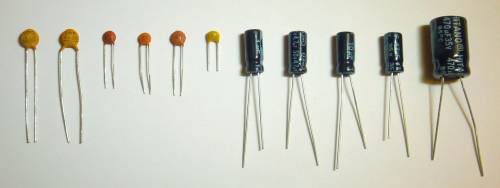Table of Contents
Capacitor
Introduction
A capacitor is a energy storing device (a component in electronics) made up generally of two parallel conductive plates separated by a dielectric insulating material.
When a voltage is applied across the plates, the electric field in the dielectric displaces electric charges, and subsequently stores the energy involved. It is assumed ideally that there are no free charges in the dielectric, and that while they are displaced, they are not free or enabled to move around as in a conductor or semi-conductor.
Dielectrics are categorized in two ways, polar and non-polar. Molecules where the center-of-gravity of the negative and positive charges are at the same point, are deemed non-polar. If that criteria is not met, the molecule is termed polar. H2O, water in molecular form, for example is polar, but H2 is non-polar. Based on that generalization, there are polarized (mostly Electrolytic) and non-polar capacitors (mostly Ceramic).
The plates may be actual metal plates of various shapes but are most often in the form of metal foil or a metal film deposited (layered) on the insulating material. Since the first capacitor was invented, the Leyden jar, almost every conceivable dielectric material and form has been tried by someone: Wax, electrochemical films, plastics, ceramics, glass, oils, paper, minerals, air, and many others, either alone or as a unitized combination such as paper/wax, paper/epoxy, plastic/plastic, paper/oil, plastic/oil have been used. The quality and quantity of such storage is termed Capacitance wich can be measured in Farads.
Capacitor specifications
- Capacitance
- Voltage rating
- Polarity
- Type : Ceramic, Electrolytic, Polyester,Polystyrene…

